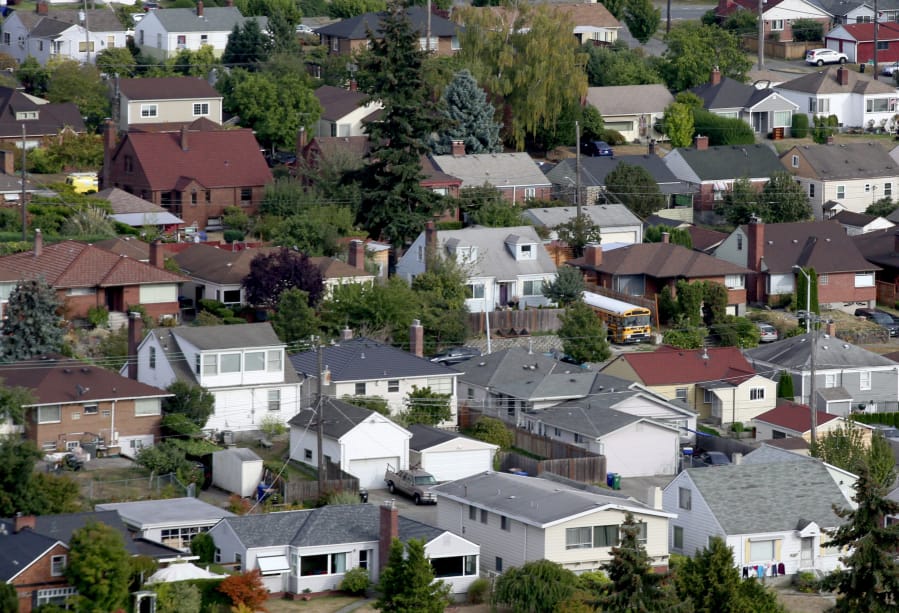The coronavirus pandemic, combined with low interest rates, spurred home buyers and sellers to change how they lived. The pandemic also changed some of their behaviors when they entered the market, according to a report the National Association of Realtors released Wednesday.
Those buying homes after the start of the pandemic bought higher priced homes, purchased more often in the suburbs, and planned to spend fewer years in their new homes, according to the association’s nationwide survey of recent home buyers and sellers in July. Those selling early in the pandemic felt more urgency to sell and sold because they needed more living space.
As expected due to the pandemic-induced economic downturn, people who bought homes after the pandemic started generally had higher incomes than home buyers before the pandemic. Those buying after March had median household incomes of $110,800, compared to $94,400 for home buyers before April, the report found. The national median price of a home that buyers purchased during the pandemic was roughly $340,000, compared to $270,000 before the pandemic.
In addition to buyers’ financial security, high buyer demand played a role. Ten or more people may bid on one property, which drives up a home’s price, said Annette Collier, broker of record at Able Real Estate in West Philadelphia.
“The buyers that don’t have the money to give more than the house’s value, they’re outbid,” she said.
Real estate agents in the Philadelphia region have been saying for months that home buyers are showing more interest in the suburbs as a result of the pandemic, which is driving yearnings for more space. The National Association of Realtors survey found that to be the case across the country. Fifty-seven% of buyers who purchased homes in the spring and early summer bought in the suburbs, compared to 50% of buyers who purchased before March.
The need for more living space was the No. 1 reason sellers gave for moving during the pandemic, replacing proximity to family and friends, which was the top reason before.
LeShadae Godfrey, a Realtor with Philly Home Girls Real Estate, said her clients in the spring and summer were moving out of apartments to buy their first homes and moving out of rowhouses for more outdoor space in the suburbs.
Buyers seem to be in the market for transitional homes. The survey found that people who bought homes this spring and early summer think they will move again more quickly. Home buyers during the pandemic plan to stay in those properties for a median of 10 years, compared to the 15 years people who bought before the pandemic.
Buyers working remotely, supervising young children learning virtually, or welcoming adult children and aging parents back home because of the pandemic can face immediate space challenges. Jessica Lautz, vice president of demographics and behavioral insights at the National Association of Realtors, said many are thinking, “I just have to find a place for right now, and I’ll figure the rest out later.”
Right after the pandemic started, when buyers were more hesitant to dive into the purchasing process, more sellers offered incentives, such as assistance with closing costs and credit toward remodeling and repairs, to attract potential buyers, the National Association of Realtors report found. Sellers felt more urgency to sell, and more of them counted on incentives to help, even in a seller’s market.
More recently, bidding wars are common. Godfrey said one of her clients moved from an apartment to a condominium and fought off five other offers to buy it. The sellers chose her, because she wrote a letter about how much she wanted it.
Buyers are spending less time looking for their homes than in any year since 2007, according to the report. Buyers spent a median of eight weeks on their home search this year, down from 10 weeks last year.
“Part of it is the lack of inventory on the market, so there’s just fewer homes to see,” Lautz said. At the same time, buyers “may feel some urgency because of the lack of inventory.”
Virtual showings and open houses and 3D tours, which have grown in popularity during the pandemic, also have been cutting down on the time buyers spend searching. Buyers can check out more houses in less time, since they don’t have to visit them in person. Godfrey said some of her clients have visited only two or three homes.
“By the third property,” she said, “they’re ready to make their offer.”



